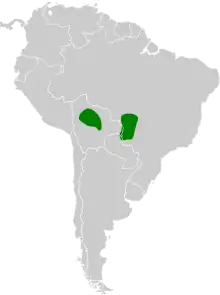| Mato Grosso antbird | |
|---|---|
.jpg.webp) | |
_01.jpg.webp) | |
| Male above, female below | |
| Scientific classification | |
| Domain: | Eukaryota |
| Kingdom: | Animalia |
| Phylum: | Chordata |
| Class: | Aves |
| Order: | Passeriformes |
| Family: | Thamnophilidae |
| Genus: | Cercomacra |
| Species: | C. melanaria |
| Binomial name | |
| Cercomacra melanaria (Ménétriés, 1835) | |
 | |
The Mato Grosso antbird (Cercomacra melanaria) is a species of bird in the family Thamnophilidae. It is found in Bolivia, Brazil, and Paraguay. Its natural habitats are subtropical or tropical dry forests and subtropical or tropical moist lowland forests.
The Mato Grosso antbird is 16.5 cm (6.5 in) in length. The male is mainly black but has white fringes on the wing coverts and white tips at the end of the tail feathers. The female has similar white fringes and white tail tips but is gray above and paler gray below.[2]
Taxonomy
The Mato Grosso antbird was formally described in 1835 by the French zoologist Édouard Ménétries under the binomial name Formicivora melanaria.[3] The specific epithet is from Latin melania meaning "blackness".[4] The type locality is the town of Cuiabá in the Brazilian state of Mato Grosso.[5][6] This antbird is now placed in the genus Cercomacra that was introduced by the English zoologist Philip Sclater in 1858.[7][8] The species is monotypic: no subspecies are recognised.[8]
References
- ↑ BirdLife International (2018). "Cercomacra melanaria". IUCN Red List of Threatened Species. 2018: e.T22701692A130215657. doi:10.2305/IUCN.UK.2018-2.RLTS.T22701692A130215657.en. Retrieved 12 November 2021.
- ↑ Ridgely, Robert S.; Tudor, Guy (2009). Birds of South America: Passerines. Helm Field Guides. London: Christopher Helm. p. 357, Plate 28.9. ISBN 978-1-408-11342-4.
- ↑ Ménétriés, Édouard (1835). "Monographie de la famille des Myiotherinae où sont décrites les espèces qui ornent le Musée de L'Académie Impériale des Sciences". Mémoires de l'Académie Impériale des Sciences de St.-Pétersbourg. Series 6 (in French). 3 Part 2: 443–543 [500–501, Plate 7, fig. c].
- ↑ Jobling, James A. (2010). The Helm Dictionary of Scientific Bird Names. London: Christopher Helm. p. 246. ISBN 978-1-4081-2501-4.
- ↑ Hellmayr, Carl Eduard (1924). Catalogue of Birds of the Americas and the Adjacent Islands in Field Museum of Natural History. Field Museum Natural History Publication 223. Zoological Series. Volume 13. Vol. Part 3: Pteroptochidae, Conopophagidae, Formicariidae. p. 224.
- ↑ Peters, James Lee, ed. (1951). Check-List of Birds of the World. Vol. 7. Cambridge, Massachusetts: Museum of Comparative Zoology. p. 217.
- ↑ Sclater, Philip Lutley (1858). "Synopsis of the American Ant-birds (Formicariidae). Part II containing the Formicivorinae or Ant-wrens". Proceedings of the Zoological Society of London. Part 26: 232–254 [244].
- 1 2 Gill, Frank; Donsker, David; Rasmussen, Pamela, eds. (January 2021). "Antbirds". IOC World Bird List Version 11.1. International Ornithologists' Union. Retrieved 6 July 2021.
